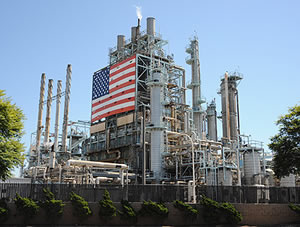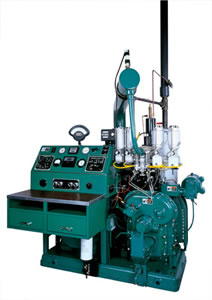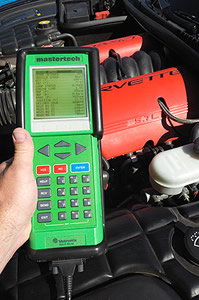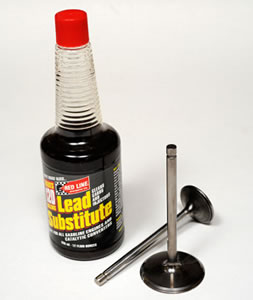Corvette Action Center Deep Dive Series: Gasoline for your Corvette - Page 2 of 8
 |
 |
Page 2 of 8
© 2009 by Hib Halverson
No use without permission, All Rights Reserved
![]() Discuss this article
Discuss this article

Crude oil is refined into gasoline at an oil refinery like this one, BP's huge Carson, California facility. Image: Author.
In addition to gasoline blend stocks, various additives are included for special purposes, such as: anti-oxidants and metal deactivators (both inhibit gum formation and improve stability), deposit modifiers (reduce combustion chamber deposits, spark-plug fouling and pre-ignition), surfactants (prevent icing, improve vaporization, inhibit deposits and reduce certain emissions), dyes (for safety or regulatory purposes) and corrosion inhibitors. Additives are used in very small amounts, usually 50-100 pounds per thousand barrels of gasoline.
We asked Tim about gasoline's "shelf life". "Gasoline is designed for cradle-to-grave of about six weeks. In normal use, it is seldom stored for longer than that, however, it has enough stability so storage for a year is not a problem."
The additive business makes a lot of money selling gasoline stabilizers to many people who really don't need them. If your storage is 12 months or less, you don't need fuel stabilizer.
Some think Corvettes stored during winter shouldn't have full tanks because of vapor-lock problems when using "winter" gas the following summer. Tim Wusz told us that with '74 and earlier Corvettes lacking rubber bladders in their tanks, moisture in an empty tank is a bigger problem than vapor-lock thus, he recommends storage with a full tank. Once spring arrives, it won't take long to dilute winter gas with summer gas.
What's Up with Octane.
In the combustion chamber, after the spark plug ignites the air-fuel charge, a "flame front" burns away from the plug. This burning needs to be controlled if the engine is going to perform well and last a long time. "Detonation" is rapid, uncontrolled combustion. It occurs shortly after the spark if the unburned charge ahead of the expanding flame front is compressed to the point of auto-ignition. If a significant amount of unburned charge auto-ignites, intense pressure waves are generated which cause the combustion chamber walls to vibrate which you hear as a knocking or pinging sound. The pressure from detonation builds quickly, before the piston reaches top dead center. When downward force builds before the piston changes direction, stress on it and other parts is significant as is the performance loss. Detonation also sends combustion temperatures soaring. The stress and temperature make even moderate detonation capable of damaging your Corvette's engine. Anti-knock rating or "octane" is a measure of a gasoline's resistance to detonation. Two ratings are common for automotive gasolines: Research Octane Number (RON) and Motor Octane Number (MON). The test for both uses a single-cylinder, variable compression ratio engine. The engine is run on a gasoline to be rated and the compression ratio is varied to obtain a standard knock intensity measured by an electronic knock-meter. The octane of the sample is determined by comparing its knock tendency with that of reference fuels having known octane numbers.

A lot of the octane testing machines in service are Waukesha "F1/F2 Octane Testing Instruments" such as this one. Image: Waukesha Engine Division, Dresser Industries.
"The MON test, because of faster engine speed, higher mixture temperature and variable spark timing, better simulates conditions in a high-performance or heavily-loaded automotive engine and is", Tim Wusz told us, "more relevant to the enthusiast trying to understand gasoline. In a real world engine, MON is necessary at wide-open throttle. It is an important number for high-performance engines since they spend a high percentage of their lives running at high speed under high-load."
The Federal Government requires octane of gas sold for road use be rated by an average of RON and MON "(R+M)/2" and that number must be on a yellow sticker applied to the gas pump. In many places, regular unleaded is 87-octane, mid-grade is 89 and premium varies from 91 to 94 octane. In high-altitude areas, you'll find lower octane gas. "Pressure and temperature in the combustion chamber are less at altitude." Wusz stated. "Engines need less octane, so Government allows slightly less octane fuel in counties having a large majority of their territory above 4000 feet. Do refiners save money selling lower octane fuel in mountain areas? Nope. They lose any savings in transportation costs. Most refineries are near coastal areas so most gasoline is transported to interior states. The farther it's moved, the more expensive it becomes."
So...how much octane do you need? Only enough to keep your Corvette's engine out of detonation. With virtually all pump gas, more than that offers no performance advantage, however, some racing gasolines can be responsible for small performance increases, even though the engine using them might not require higher octane.
How do you determine an engine's detonation threshold? With older Vettes lacking computer controls, do that through testing and the first test instrument is your ear. If you hear detonation when the engine is under load, you have a problem. If that's at high rpm, you have a severe and dangerous problem. Severe detonation will melt plug electrodes and/or crack their center insulators. It also can damage valves, crack heads and break pistons. If there's no tuning issue (ie: too much spark advance, lean mixture, etc.) causing the detonation, then you need more octane. Plug reading can, also, identify a detonation problem. If you see small black or gray spots on the core nose of the spark plug, the engine is probably detonating. If there are tiny flecks of aluminum on the plugs, that's evidence of detonation which is a little more substantial.

With '81 or later Vettes, one way to assess if your gas has sufficient octane is to road test and watch or record knock sensor data with a scan tester, such as this Bosch MTS3100 Mastertech. Image: Author.
All 1981 or later Corvettes, have computer control of spark advance and will be equipped with a knock sensor (KS). If the KS senses detonation, the engine computer retards the spark enough to stop the detonation. You can use a scan tester to view the KS signal and/or the spark retard value. If the tester indicates detonation and there's no engine-related trouble causing it; then you need higher octane gas.
Get the Lead Out.
The octane and valve-seat-durability enhancing qualities of alkyl-lead compounds (chiefly tetraethyl lead, aka: "TEL" or just "lead") were discovered in 1922 by General Motors. By the late-'20s, leaded gas became available and, by the early '50s, TEL was in virtually all gas sold in the U.S. By the '60s, super premiums averaged 3.5-grams TEL per gallon and were around 100 RON. While TEL was a cheap way to improve performance and durability, it is toxic, both unburned in gasoline and in lead-oxide-particulate form in exhaust gases. In the late 1960s, concerned with public heath effects of TEL, the Federal Government legislated its phase-out. Gasoline retailers had to make unleaded gas available by July, 1974. Following that, stepped limits on lead were enacted starting with 1.7 grams per gallon in 1975 and dropping to 0.1 g/gal. in 1986. These were the low-leads of the '70s and '80s.
Lead's phase-out forced octane reductions. While it didn't cause detonation in new Corvette engines, because, starting in MY71, GM had lowered compression ratios as a technical response to government restriction of oxides of nitrogen (NOx) emissions; it did cause detonation in older, high compression engines. The solutions were either mixing racing or aviation gasoline with the pump gas, changes to the engine's spark curve or lowering of the engine's compression ratio. Following the phase-out of TEL, to meet new exhaust emissions regulations for model year 1975 (MY75), some manufacturers added exhaust catalytic reactors to their vehicles and GM did that with Corvette. By MY80, all light duty vehicles had them. Also known as, catalytic converters, catalysts or just cats, these reactors convert pollutants to non-polluting substances. Alkyl-lead destroys that ability, so any catalyst-equipped vehicle had to use unleaded gas. As a result, leaded gas use peaked in 1977, then declined rapidly. In December, 1995, use of gasoline with more than 0.05-gram alkyl-lead per gallon (in a practical sense, all leaded gas) by any on-highway vehicle built after MY75 was outlawed.
By the mid-'80s, car companies were learning better ways to control emissions. Additionally, to increase octane, refiners began to blend aromatic hydrocarbons in premium unleaded gasoline. To a lesser extent, the addition of oxygenates, also, increased octane. As a result, compression ratios began to climb, again. Today, modern engine controls and combustion chamber dynamics along with premium unleaded gasoline allows compression ratios as high as the '06-'10 LS7's 11:1.
Additives You Might Need:
The phase-out of TEL, also, eliminated alkyl-lead's protection of the valve seats in the cast iron cylinder heads which were on the vast majority of engines back then. Metallic oxide byproducts of lead's combustion left a protective coating on valves and seats. Without that protection, when valve temperatures were high, during severe duty or extended operation with lean mixture, the soft cast iron of the valve seats weakens and pieces of the material wear away causing the seats to recede into the head. Debris from this rapid wear caused additional damage to valve stems and guides. The end result was poor valve sealing and eventual cylinder head repair or replacement.

Red Line's Lead Substitute is the ideal solution for pre-'71 engines which don't need octane any higher than that of pump gas but do need the valve seat protection once available with leaded fuel. Image: Author.
GM's response to this problem was the introduction of cast iron heads with induction-hardened valve seats. The rest of the industry soon followed for the 1971 model year. The few aluminum heads available back then never experienced such a problem because of their hardened steel, valve seat inserts. With the last of the heads with soft seats being made nearly 40 years ago, pre-1971 cast iron heads still in service are pretty rare. While it is true that an engine having heads without induction-hardened seats or hard seat inserts, may experience valve seat recession when run on unleaded gas, reality is that soft seats will have better durability than urban legends lead many to believe. If you've got old heads on a show car or weekend cruiser that sees low annual mileage, infrequent high-rpm/high-load use and has an engine in good condition; problems from valve seat recession are unlikely.
Conversely, if the car sees high annual mileage or you drive it hard on a regular basis, then you need to either retrofit hard seat inserts to your existing heads, install later iron heads with induction-hardened seats or add something to the gasoline to inhibit valve seat recession. If the seats are already recessed or otherwise worn, the additive strategy won't work and cylinder head repair or replacement is your only choice.
There are pour-in additives which prevent valve seat recession. The CAC has test data showing Red Line Synthetic Oil Corporation's "Lead Substitute" is an excellent solution to valve seat recession. Lead Substitute uses a sodium-based chemistry which forms sodium oxides upon combustion, offering protection similar to that of TEL but without lead's toxicity. Red Line Lead Substitute comes in 12-oz. bottles, is mixed 1-oz. per 10 gallons of fuel and should be used in every tank of gas for best protection.
Occasionally, products which absorb water from gas and provide fuel system freeze protection are necessary. Trouble with water in gas are rare in areas where reformulated gasoline (which is oxygenated with ethanol) is available, however, if you live in a place where RFG is not available, below freezing temperatures are the norm or water in gasoline is a common problem, you might need an additive capable of removing water and or preventing it from freezing in the fuel system. Best known of these products is "Drygas" developed 45 years ago by the Cristy Corporation. Drygas is alcohol based. It can absorb small amounts of water in your gas tank and can prevent unabsorbed water that's left from freezing and restricting or obstructing fuel flow.
Another is "Fuel System Water Remover and Antifreeze" from Red Line Synthetic Oil Corporation. It will disperse an equal amount of water in gasoline in a manner which allows it to go through the engine and out the exhaust as steam. It also reduces the freeze point of an equal amount of water to 0°F. This product can treat up to 250 gallons of fuel.
The most popular pour-in gas additives are injector cleaners. They are used for either of two reasons, to clean out a problem in the fuel system, such as fouled injectors, gunky intake valves, a dirty carburetor or deposits in the fuel supply system, or as a maintenance measure to prevent deposits from accumulating in injectors, on valves, in carburetors or on other fuel system parts.
 |
 |